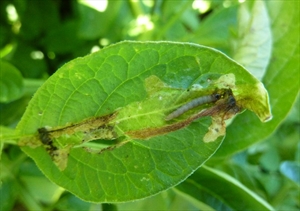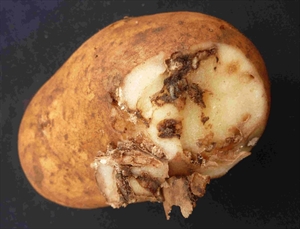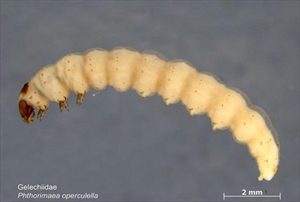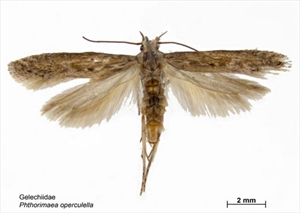Potato tuber moth
Pacific Pests, Pathogens, Weeds & Pesticides - Online edition
Pacific Pests, Pathogens, Weeds & Pesticides
Potato tuber moth (298)
Phthorimaea operculella. It is a member of the Gelechiidae.
Asia, Africa, North, South and Central America, the Caribbean, Europe, Oceania. It is recorded from Australia, Fiji, French Polynesia, Guam, New Caledonia, New Zealand, Papua New Guinea, and Tonga (requires confirmation).
Narrow: potato, tomato and tobacco are the main hosts, with some other crops and weeds in the potato (Solanaceae) family, e.g., capsicum, eggplant, and nightshade.
The caterpillars (larvae) of the moth do the damage. They attack potatoes in the field and in storage. The larvae mine the young leaves and tunnel into the tubers, leaving frass (faeces and other remains) from tunneling at the entrance. When the larvae leave the tunnels, fungi, bacteria and mites take over, and tubers rot and have an unpleasant smell.
Attack on the tubers begins when the plants are starting to die, and the tubers are maturing; as they grow larger the tubers come nearer the soil surface. At this time, the soil cracks and the larvae move from the foliage to attack the tubers, and to lay eggs on or near them. Infestations are worse in heavy soils that crack when dry.
The moth is most active at dusk. Eggs are laid in groups of up to 250 on leaves and exposed tubers. They hatch and the larvae feed in mines or tunnels in the stems, leaves and tubers (Photos 1-3). Larvae are whitish at first with black heads, and a pinkish area behind the head (Photo 4). They become green as they mature. The larvae grow to 15 mm and after about 2 weeks they pupate. Pupation takes place mostly in the soil but can also occur on the leaves. If pupae develop in storage they occur between tubers or in the entrance to the larval tunnels. The adults are 8-10 mm long with fringed brown wings with dark spots (males) and an X pattern (females) when the wings are together (Photo 5). They live for up to 10 days.
Survival between crops occurs as pupae in the soil, or in discarded (cull) piles of potatoes left in the field at harvest.
The greater impact is caused by the larvae tunneling into the tubers, rather than the mining of leaves and stems. Tubers are frequently damaged if harvests are delayed or tubers are not treated in storage. The boring makes the tubers unmarketable, both for the fresh market and processing. Infested tubers are a source of the pest for future crops. Losses in developing countries are often high, with reports of more than 50% loss from countries in the Middle East, North Africa, South America, Asia and East Africa.
Look for the mines in the leaves, and tunnelling in the leaf stalks and stems. Look especially for frass at entrance holes in tubers at harvest and in storage; if frass is seen cut the tubers open to find the larvae. A chemical is available that attracts male moths, and this can be used to monitor moths in the field and storage before deciding if chemical control is necessary.
NATURAL EMNEMIES
There are three wasp parasitoids that attack the potato tuber moth, Orgilus lepidus, Apanteles subandinus and Copidosoma koehleri. They are larval parasites, with Copidosoma also attacking eggs. These have been distributed from South America to other countries. In Australia, several parasitoids have been released, but these three are the most important. Parasitism up to 80% has been recorded. Predators are spiders, earwigs, and ladybird beetles.
CULTURAL CONTROL
Before planting:
- Choose seed carefully, preferably healthy seed, certified by government agencies.
- Remove weeds and volunteer plants as these can be alternate hosts of the tuber moth.
- Test whether intercropping with onion, garlic or chillies is useful. There is experimental evidence that damage to both potato (tuber damage) and tomato is reduced by intercropping, although the reasons for this are unknown.
During growth:
- Plant as deeply as possible, and hill-up (frequently) to prevent the moth laying on exposed tubers. It is important to hill-up late in the season when the tubers are large, but before they are exposed. Throw the soil high around the base of the plants.
- Mulching 4 weeks before harvest has been found to be useful. In trials, neem leaves have been used, but this treatment is yet to be taken up by farmers.
- Grow flowering plants in gardens or at the side of fields to attract parasitoids. Dill and coriander are suggested.
- Harvest as early as possible, and bag and remove potatoes from the field immediately.
After harvest:
- Do not cover tubers with potato vines after harvest, when waiting to remove them from the field; the vines wilt exposing the tubers to the moth.
- Make sure that all tubers are harvested, do not leave rejects (cull piles) in the field which can extend survival of the moth until the next crop is planted.
- Do not grow consecutive crops of potato on the same land; practice crop rotation. And do not plant tomatoes after potatoes.
- Do not grow over-lapping crops of potato close to each other; separate young crops from old by as much distance as possible.
- If possible, store tubers below 9°C.
RESISTANT VARIETIES
Several varieties have shown fair resistance, including King Edward and Russett Burbank, and some others are moderately resistant. Ask your supplier for information about varieties. Note those with low leaf infestation also show low tuber damage.
CHEMICAL CONTROL
Neem has been used to control the potato tuber moth in storage. In Australia, the following insecticides are registered against potato tuber moth: methomyl, indoxacarb, diazinin, carbaryl, abamectin (derived from a soil bacterium), spinosad (derived from a bacterium), and the pyrethroids, permethrin and bifenthrin.
____________________
When using a pesticide, always wear protective clothing and follow the instructions on the product label, such as dosage, timing of application, and pre-harvest interval. Recommendations will vary with the crop and system of cultivation. Expert advice on the most appropriate pesticide to use should always be sought from local agricultural authorities.
AUTHOR Grahame Jackson
Information from CABI (2015) Phthorimaea operculella (potato tuber moth). Crop Protection Compendium. (https://www.cabi.org/cpc/datasheet/40686); and from Harsimran K, et al. (2014) Featured Creatures: Potato tuberworm. UF/IFAS, University of Florida. (http://entnemdept.ufl.edu/creatures/VEG/POTATO/potato_tuberworm.htm). Photos 1-3 Western Australian Agriculture Authority (Department of Agriculture and Food. WA). Photos 4&5 MAF Plant Health & Enviroment Laboratory (2011) Potato Tuber Moth (Phthorimaea operculella. (PaDIL - (http://www.padil.gov.au).
Produced with support from the Australian Centre for International Agricultural Research under project PC/2010/090: Strengthening integrated crop management research in the Pacific Islands in support of sustainable intensification of high-value crop production, implemented by the University of Queensland and the Secretariat of the Pacific Community.








